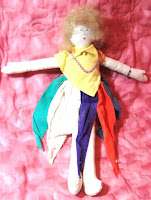I am in the mood to make dolls and when I read a blog I posted a couple of years ago, I became even more inspired. I thought I would repost this for you to read.
I make dolls. I have made dolls for over 30 years. But I never really considered myself a doll maker until recently. I usually made dolls to do other crafts.
Since I am a fiber
artist, most of the dolls I make are cloth dolls. Cloth or rag dolls (often called that because
they were made and stuffed with rags) have been around for thousands of
years. The earliest one knon is about
1700 years old. It was found in a grave
from Ancient Rome and was made of linen.
There are not many cloth dolls around because they were literally loved
to pieces,
My doll making actually started with teddy bears. I found a wonderful pattern and began making bears for gifts and for charity. I gave dozens to homeless and abused women shelters for the children staying there
I then found a pattern for little felt bears. Felt was wonderful to use because it doesn’t fray. The fun part of these bears was you could dress them in various outfits. I made a lot of these as gifts creating outfits to fit the recipients’ personality.
I think my first doll was from a fabric panel. Panels often have all the parts of a doll or
animal printed on the fabric including the instructions. You just cut them out
and sew them up. What I liked about this
doll was more the embroidery than the doll.
At the time the doll was just to show off the embroidery I did.
Then around 2000 I was reading a book on creativity and there was an exercise called the Creativity doll. The idea was to create a doll that represented something you wanted in your life: love, marriage, increased income, etc. Think of it as putting a wish into a 3 dimensional form. I wanted to be more of a free spirit so I made the doll following a pattern but her outfit was designed as I went along.
I have made a doll using colored pencil on fabric.
And my latest was the embellished doll I did during my
birthday creativity retreat last year.
You don’t have to consider yourself a doll maker to create a doll. I didn’t for a long time. But some time when you are stuck for what to create or you just want to play try making a doll. And, hey guys, no one says you can’t make dolls.
©2018, 2021- Cheryl E. Fillion






